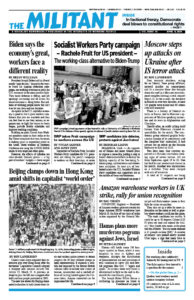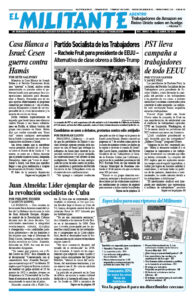President Joseph Biden and his liberal media “spin doctors,” desperate for ways to boost his lagging reelection campaign, are working overtime to pitch the U.S. economy in the most positive light. They insist inflation is falling, and job openings increasing and all across the board everyone is doing better. But millions of working people know this isn’t true for our class and our families.
An uptick in the U.S. capitalist economy is good in that it gives workers confidence that jobs are available and they can feel free to use their unions, or organize one, to fight the bosses to boost wages, provide livable schedules and improve working conditions.
Building on gains United Auto Workers members made in their strike at the Big Three auto plants last year, the union is making gains in organizing plants in the South. Hotel workers in Southern California are using the UNITE HERE union to win wage and other gains.
However, the effects of inflation are class-divided. Grocery prices — a big part of workers’ budgets — have surged 25% over the last four years. Workers are forsaking chain grocery stores and turning to discounters like Dollar General and Aldi. Dollar General says it now has a store within 5 miles of 75% of the U.S. population.
To keep profits up and prices down, discount-store bosses advise the food producers who serve them to “shrink” the size of their packages.
While the ruling capitalist families and those in the upper middle class dependent on their rule don’t face the same crisis, they are worried about the state of the economy. Gold prices have risen to record levels, hitting $2,182 an ounce March 12.
Investors are nervous about the stability of today’s capitalist “world order,” and are looking for “safe havens” to turn to. Whenever the bankers and bosses get nervous, one key sign is a flight into gold.
Central banks around the world “accelerated their purchases” of gold “after Russia’s invasion of Ukraine in early 2022,” reported the Wall Street Journal. “Then in October, gold jumped 5% after Hamas attacked Israel. It is now 19% higher than when the conflict began.”
“Hold the Inflation Champagne,” wrote the Journal’s editorial board the same day, reporting February’s 3.2% annual inflation rate means the ravages of price rises still threaten their economy. “The inflation pace for the last three months at an annual rate is faster than for the last 12 months,” they admitted.
Prices have risen for many household items, and they’re not coming down. Prices to go out for a meal are 30% higher than in 2019. Some restaurant bosses are protecting their profits by introducing “surge pricing” on their menu during normal meal times. Some have begun imposing a $20 booth fee at rush hour.
Gasoline prices, which dropped from a high of over $5 a gallon a year ago, are rising again. This worries the election-obsessed Biden administration. For this reason, the White House is urging Ukraine’s government to halt drone strikes on Russia’s oil facilities, fearing they push world fuel prices up.
Half of us who rent an apartment spend at least 30% of our income on rent. Average 30-year home mortgage rates are now 6.74%, almost double what they were two years ago. This makes it increasingly difficult for young people to set out on their own and afford a place to raise a family.
“The U.S. economy is sinking into a 1970s-style dilemma where inflation sticks around but the economy cools,” wrote the scribes at MarketWatch March 16.
The Socialist Workers Party 2022 political resolution, printed in The Low Point of Labor Resistance Is Behind Us: The Socialist Workers Party Looks Forward, says, “An extended period of stagflation, combining inflation with stagnating capitalist production and hiring, is increasingly likely both in the US and worldwide.”
Declining number of full-time jobs
The number of workers with full-time jobs has declined over the past three months, the Labor Department reports. Throughout 2023 nearly three-quarters of jobs added in the U.S. were in lower-paid positions in hotels, restaurants, health care and lower-level government jobs. In many cases these involve part-time hours, leaving workers to search for a second job to cover family expenses. For the 275,000 new jobs announced for February this trend continues. Job growth is declining in manufacturing and other key productive sectors of the economy.
For those working, nearly a third say they’ll never be able to afford to retire. As many as 28% of U.S. workers say they’ve been unable to put aside anything for retirement. Nearly 40% of workers say they don’t have enough ready cash to cover a $400 car breakdown, family health problem or any other emergency expense.
Increasing numbers of workers depend on using credit cards to cover their rising expenses, a boon for the big bankers who make superprofits by charging usurious monthly interest rates on unpaid balances. The average interest rate today is 21.5%, up nearly 7% from two years ago. And workers’ overall unpaid balances are growing. Total credit-card debt topped $1 trillion last year.
Car prices — both for new and used vehicles — have jumped, as has the cost of a loan to buy one. Some 20% of us owe more on our loans than our car is worth.

